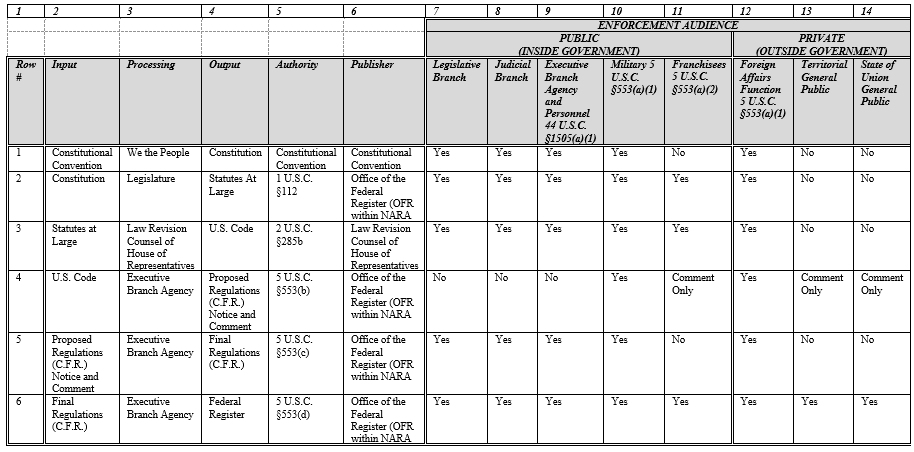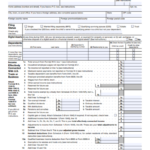Statutes, Regs, Jurisprudence
Every government in America consists of three branches:
- Legislative Branch: Enacts civil and criminal laws as statutes. These statutes are published in the Statutes at Large.
- Executive Branch: Executes the statutes and, if they apply to the general public, also publish regulations that implement the statutes and give notice to the public how they will be enforced.
- Judiciary: Enforces the statutes and regulations against the intended audience when there are disputes among parties. Judicial decisions are published in the legal publications and online.
The three branch system of government was first described in the following now famous book first published in 1752:
The Spirit of Laws, Baron De Montesquieu
https://famguardian.org/Publications/SpiritOfLaws/sol.htm
There is a hierarchy in the legislative process for the constitution, statutes, and regulations. It goes as follows:
- The constitution requires Congress to do something.
- Congress enacts a statute to implement what the constitution requires. The statute by default is a COMMAND to the Executive branch.
- The Executive Branch then examines the statute to decide whether there is a need to publish regulations to implement the statute as against the public. If so, they publish implementing regulations in the Federal Register.
- When notice and comment in the Federal Register, the regulation is then codified in the Code of Federal Regulations (C.F.R.).
The above process is further broken down in the table below:

NOTES:
1. The above diagram shows the process by which laws are made, and how they trickle their way down during their evolution to become the Statutes at Large (SAL), the U.S. Code, and the Code of Federal Regulations (C.F.R.).
2. The chronology is vertical and begins at the top and trickles its way through time to the bottom almost like a Pachinko Machine:
https://en.wikipedia.org/wiki/Pachinko
3. Chronologically, a lawfully enacted law item over time falls to the level below it as an input.
3.1. The INPUT on a given level in Column 2 derives from the OUTPUT on the level above it in column 4, for instance.
3.2. The further down the vertical hierarchy a law goes, the larger the audience for its enforcement.
3.3. If an item does NOT involve a foreign affairs function, then it can’t affect a private human until it reaches Row #6. See 5 U.S.C. §552(a)(1) and 26 C.F.R. §601.702.
3.4. Federal enforcement authority is documented in:
| Federal Enforcement Authority Within States of the Union, Form #05.032** (Member Subscriptions) https://sedm.org/product/federal-enforcement-authority-within-states-of-the-union-form-05-032/ |
4. The horizontal axis represents the entities affected by that law or regulation, divided between INSIDE the government and OUTSIDE the government.
4.1. The column INSIDE refers to activities within the government involving only government officers and agents. This is the origin of the word “INTERNAL” within the phrase “INTERNAL Revenue Service”.
4.2. The column OUTSIDE refers to enforcement activities by government actors AGAINST private humans protected by the Constitution within the exclusive jurisdiction of a Constitutional state and abroad. These people are all NONRESIDENT ALIENS. See:
4.2.1. Proof that American Nationals are Nonresident Aliens, Form #09.081
https://sedm.org/Forms/09-Procs/ProofAnNRA.pdf
4.2.2. Nonresident Alien Position Course, Form #12.045
https://sedm.org/LibertyU/NRA.pdf
4.2.3. Non-Resident Non-Person Position, Form #05.020
https://sedm.org/Forms/05-MemLaw/NonresidentNonPersonPosition.pdf
4.2.4. Rebutted False Arguments About the Nonresident Alien Position When Used by American Nationals, Form #08.031
https://sedm.org/Forms/08-PolicyDocs/RebArgNRA.pdf
4.3. Franchisees are listed as WITHIN the government because franchises are always implemented with offices. See:
4.3.1. Government Instituted Slavery Using Franchises, Form #05.030
https://sedm.org/Forms/05-MemLaw/Franchises.pdf
4.3.2. Proof That There is a “Straw Man”, Form #05.042
https://sedm.org/Forms/05-MemLaw/StrawMan.pdf
4.3.3. Why Statutory Civil Law is Law for Government and Not Private Persons, Form #05.037
https://sedm.org/Forms/05-MemLaw/StatLawGovt.pdf
4.4. A public officer in this scenario is merely anyone that the government can CIVILLY enforce against. CIVIL obligations are property, and being able to enforce is a TAKING of property that requires consent to become an officer before hand. Otherwise, it would be a common law trespass:
“The term office’ has no legal or technical meaning attached to it, distinct from its ordinary acceptations. An office is a public charge or employment; but, as every employment is not an office, it is sometimes difficult to distinguish between employments which are and those which are not offices….A public officer is one who has some duty to perform concerning the public; and he is not the less a public officer when his duty is confined to narrow limits, because it is the duty, and the nature of that duty, which makes him a public officer, and not the extent of his authority.’ 7 Bac. Abr. 280; Carth. 479…. Where an employment or duty is a continuing [***65] one, which is defined by rules prescribed by law and not by contract, such a charge or employment is an office, and the person who performs it is an officer….”
By “public” above, they mean the “State” or the “Body politic”. STATUTORY civil obligations require MEMBERSHIP in the “State” effected through VOLUNTARY DOMICILE.
4.5. It is a Third Rail Issue that participating in government franchises requires you to have an office within or act as an agent of the government. See:
| Third Rail Government Issues, Form #08.032 https://sedm.org/Forms/08-PolicyDocs/ThirdRailIssues.pdf |
4.6. NO ONE can FORCE you into a franchise office position. If they do, it is a violation of the Thirteenth Amendment. Even if you APPLIED to participate, you STILL are not OBLIGATED to participate and can be OFF DUTY during times of YOUR choosing.
4.7. Whether you are ON DUTY INSIDE the government or OFF DUTY OUTSIDE the government depends on whether you invoked the FRANCHISE MARK in connection with specific property. By FRANCHISE MARK, we mean the Social Security Number or the Taxpayer Identification Number. These FRANCHISE MARKS constitute a de facto license to represent the state as an officer of the state. Voluntarily attaching the FRANCHISE MARK to specific otherwise PRIVATE property constitutes consent or an “election” to donate PRIVATE property to a PUBLIC use, a PUBLIC PURPOSE, and a PUBLIC OFFICE to procure the “benefits” of the franchise. See:
| About SSNs and TINs on Government Forms and Correspondence, Form #05.012 https://sedm.org/Forms/05-MemLaw/AboutSSNsAndTINs.pdf |
5. The various entities listed above include:
5.1. Office of the Federal Register
https://www.archives.gov/federal-register/about
5.2. Office of the Law Revision Counsel of the House of Representatives.
https://uscode.house.gov
6. For a more complete treatment of this subject, see:
Challenging Jurisdiction Workbook, Form #09.082
https://sedm.org/Forms/09-Procs/ChalJurWorkbook.pdf
Statutes and regulations use “terms” rather than mere “words” that are unfamiliar to those without legal training. Every “term” has a custom definition provided in the statute that uses it which usually varies from the “term’s” ordinary use. If you read a law without reading the definitions of “terms” first, you are likely to reach a very inaccurate understanding on what the statute or regulation requires. There is an entire set of fixed rules that legislators use when drafting statutes and regulations and that judges in the judiciary use to interpret statutes and regulations. These rules are known as the Rules of Statutory Construction and Interpretation. You can find a summary of those rules in:
Statutes and Statutory Construction, J.G. Sutherland, Second Edition, 1904
Volume 1: https://www.google.com/books/edition/Statutes_and_Statutory_Construction/Jw49AAAAIAAJ?hl=en&gbpv=1&printsec=frontcover
A very important skill is to develop the ability to do legal research by being able to locate and read and understand statutes, regulations, and jurisprudence. It is beyond the scope of this simplified website to teach that skill in its entirety. The following free online resources should prove useful in this area:
- Legal Research and Writing Techniques, Form #12.013-SEDM
https://sedm.org/LibertyU/LegalResearch.pdf - Legal Research Sources, Family Guardian Fellowship
https://famguardian.org/TaxFreedom/LegalRef/LegalResrchSrc.htm - State Legal Research Sources. Family Guardian Fellowship
http://famguardian.org/TaxFreedom/LegalRef/StateLegalResources.htm
